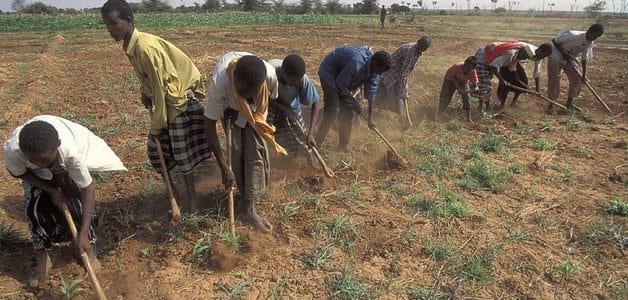
Integrated approaches to empower young African women and men to take their place in a modernized agricultural sector are needed throughout the continent.
For many months now, the news has been full of continuous reports of casualties in the Mediterranean sea of boots carrying migrants from the African continent to Europe. In April this year only, more than a thousand migrants have drowned or gone missing in the Mediterranean trying to cross from the African continent. Tens of thousands more have survived and are either waiting on the Italian island of Lampedusa or other migrant entry points to be let in or have already made it into the European continent. These numbers are on the rise; not only in Italy, but across the Mediterranean.
There is a link of course with conflict and persistent political instability in the Middle East and parts of Northern Africa. But, there are at least as many who try to escape economic distress, risking their lives in search for a better future. Much of Africa’s youth sees migration as the only way out. For example, a recent representative survey indicated that between 64 and 82 per cent of Senegalese 18 to 25 year olds would emigrate if the opportunity arose, preferably to Europe.
Hope: youth and agriculture
Such perceptions and preferences persist despite strong economic growth. GDP growth on the African continent has outpaced the world’s average over the past decade and 7 out of the 10 fastest growing economies are in Africa. But, growth has not been socially inclusive. Two of the keys to change this outcome are youth and agriculture.
Effectuating this change will be challenging, however, as investment and policy priorities in much of Africa are currently not focused on agriculture and few young people therefore see a future for themselves in the sector.
Agricultural productivity growth has been the foundation of successful development experiences. These experiences have been more inclusive when they directly engage poor smallholder farmers and when, at least in the initial stages, productivity growth is accompanied by local rural employment growth, both on and off the farm. This notion is particularly important in the African context.
Over half of the African population is expected to remain rural until the middle of this century. Also, agriculture should be expected to remain the main source of employment.
Some contend that Africa could modify its employment structure and reduce its dependence on primary production (agriculture and mining) more rapidly, making a more radical, game-changing shift to manufacturing, as happened in East and South Asia. This kind of optimism may underlie the continued relative neglect of agriculture in Africa. It may, however, be unwarranted. Such structural changes take time and could leave many behind during the transition. A scenario analysis by the World Bank suggests that even if, over the next five years (2015-20), Africa were to match the recent fast industrial growth and high demand elasticity for manufacturing workers of South Asian countries like Vietnam and Cambodia, its employment structure would still not have changed very much: no more than about 10 per cent of new job creation in favour of industrial sector workers, representing a small change in the prospects of new labour market entrants. Several decades of high growth will be needed for a more significant shift.
About 60 per cent of the continent’s population is under 25. Over the coming decade, at least 11 million young workers are expected to enter Africa’s labour markets every year. If it wants to cash in on this demographic dividend, Africa cannot afford to leave its youth in the waiting room. Some are referring to this growing problem as ‘waithood‘ to describe the indefinite period between childhood and adulthood, in which people cannot expect assistance from parents or the state, but do not enjoy the privileges of full-fledged adulthood either. How does African youth respond to this exclusion from adulthood? Riots and political mobilization can be part of the reaction, targeting the policies and structures that might be blamed for the predicament of young people. Migration is another response.
Rural youth face many hurdles in trying to earn a livelihood. Pressure on arable land is high in many parts of the world, making it difficult to start farms. Young people often also lack access to credit, and many other productive resources necessary for agriculture. But even if such hurdles could be overcome, aren’t urban life or life abroad much better? Perhaps, but only if you can make it there.
The challenges facing Africa’s rural youth are also tied to the future of food security. Africa’s farmers are ageing, pushing the age of 60 on average (!). Older farmers are less likely to adopt the new technologies needed to sustainably increase agricultural productivity, and ultimately feed the growing world population while protecting the environment. Hence, there are multiple reasons to re-engage youth in agriculture. But can this be done?
Key challenges and solutions
A recent publication of the Food and Agriculture Organization of the United Nations (FAO), the International Fund for Agricultural Development (IFAD) and the Technical Centre for Agricultural and Rural Cooperation (CTA) provides real life examples of how this can be done. The report, “Youth and Agriculture: Key Challenges and Concrete Solutions” shows, as one example, how tailor-made educational programmes (such as the Junior Farmer Field and Life Schools, JFFLS, approach) can provide rural youth with the skills and insights needed to engage in farming and adopt environmentally friendly production methods. With some additional effort, through farmers’ organizations and improved infrastructure, young farmers can connect to markets to sell their often higher value food. Facilitating youth’s access to credit helps them become entrepreneurs, improving their self-esteem and the feeling that they can make a living in rural areas.
None of this will come easily. There are no silver bullets. However, the large number of successful initiatives presented in this study offer a sense of hope. There are workable solutions to overcome the challenges faced by young women and men trying to engage in agriculture and earn a living in rural areas. Many of the initiatives reported in this study originate with young people themselves. But these initiatives also show that they can only thrive with the right kind of “enabling environment”. Much of that enabling environment has to do with adequate infrastructure and policies that improve conditions on both the supply (skills etc.) and demand side (productive and employment generating capacities) of agricultural and rural labour markets.
The JFFLS approach mentioned earlier provides a good example of what this implies. Skills development (human capital) including knowledge of farming practices, how to run a business and attitudes to life, is at the core. But such skills will need to become “deployable” by creating conditions allowing young entrepreneurs access to markets and credit and the development of producer organizations and groups facilitating knowledge sharing and overcoming constraints to economies of scale. Pushing for such conditions will require further coaching and peer group support to reach the scale and quality of production required to sustainably access local and regional markets.
Such integrated approaches to empower young African women and men to take their place in a modernized agricultural sector are needed throughout the continent. They will also need to be brought to scale if they are to make a difference in the fight against poverty and food insecurity and if they are to offload some of the pressure on distress migration. This in turn will require much greater priority in public investment programmes for agriculture and rural development and stronger incentives to private investments. The one major asset Africa possesses is “youth power”. Creating new generations of young farmers and rural entrepreneurs will be critical to collecting the dividend.




